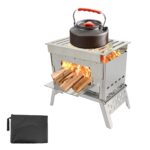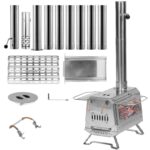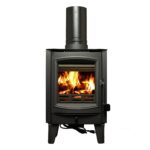
Introduction to Wood Burning Camping Stoves
Wood burning camping stoves have gained significant popularity among outdoor enthusiasts, providing a practical solution for cooking meals in a sustainable manner. Unlike traditional propane or gas stoves, these stoves utilize readily available natural fuel sources, such as twigs, branches, and other organic materials found in the surrounding environment. This not only reduces reliance on non-renewable energy sources but also minimizes the environmental impact associated with fuel transportation and storage.
The advantages of using a wood burning camping stove are manifold. For one, they allow campers to embrace a more primitive and enjoyable cooking experience, enhancing the overall ambiance of outdoor adventures. The sound of crackling wood and the warmth emanating from the fire create a comforting atmosphere, ideal for sharing meals and stories under the stars. Moreover, the ability to cook using materials found in nature makes wood stoves an appealing choice for minimalist campers who prefer to travel light.
Furthermore, wood burning camping stoves are often lightweight and portable, designed specifically for outdoor use. Many modern models incorporate innovative designs that enhance efficiency while reducing smoke output, making them a practical choice for environmentally conscious campers. The growing concern for sustainability in recreational activities has reinforced the appeal of these stoves, leading to increased awareness and adoption among outdoor communities.
As more individuals seek ways to reduce their carbon footprint and engage with nature responsibly, the wood burning camping stove has emerged as a popular alternative for outdoor cooking. With a combination of practicality, accessibility, and the joy of cooking over an open flame, these stoves represent an excellent choice for anyone looking to enhance their camping experience.
Benefits of Wood Burning Stoves
Wood burning camping stoves offer a myriad of advantages that make them an appealing choice over traditional gas or propane stoves. One of the primary benefits is their cost-effectiveness. Wood is typically abundant and often available for free in many camping environments. Campers can easily collect fallen branches, twigs, or use wood scraps, significantly reducing the costs associated with fuel. In contrast, purchasing gas or propane can quickly add up, making wood burning stoves a more economical option in the long run.
Another noteworthy advantage is the environmental impact of using wood burning stoves. Unlike fossil fuels, which release carbon dioxide and other greenhouse gases, burning wood can be a carbon-neutral process. The trees used for fuel absorb carbon dioxide during their growth, which goes some way to offset the emissions from burning them. For environmentally conscious campers, this represents a much greener alternative when considering cooking options in the great outdoors.
The availability of fuel also sets wood burning stoves apart. In remote or wilderness areas, gas canister supplies may run low or become difficult to transport. Conversely, wood is often found in abundance, reducing the dependency on commercial fuel sources. This factor enhances the overall camping experience, allowing for greater independence and connection with nature.
Moreover, many outdoor enthusiasts argue that cooking over an open flame imparts a unique flavor to food that is hard to replicate with gas or propane stoves. The smokiness and subtle depth achieved from burning wood can elevate the taste of simple meals. Anecdotes from campers often highlight this aspect, with many recalling the delicious memories tied to their wood-fired creations.
In conclusion, the numerous benefits of wood burning stoves—ranging from cost-effectiveness and environmental friendliness to the availability of fuel and flavor enhancement—make them an excellent choice for camping enthusiasts looking to enhance their outdoor cooking experience.
Key Features to Consider
When selecting a wood burning camping stove, several critical features must be evaluated to ensure optimal performance and user satisfaction. First and foremost, weight is an essential factor, especially for campers who prioritize portability. A lightweight stove can make a significant difference during hikes, as it minimizes the overall load. Most camping enthusiasts prefer stoves under 5 pounds, as this facilitates easier transport without sacrificing functionality.
Size is another vital aspect to consider. The dimensions of the stove will affect how much cooking surface is available and how easily it can fit into your camping gear. A compact stove is beneficial for solo camping or small groups, while larger models may be better suited for family outings where cooking for multiple people becomes necessary.
Burn efficiency plays a crucial role in the stove’s performance. A high-efficiency wood burning camping stove can produce more heat with less fuel, enabling campers to enjoy a warm meal without an excessive amount of wood. Furthermore, stoves designed with advanced combustion technologies often result in reduced smoke, making for a cleaner and more enjoyable camping experience.
Ease of use is an important element that should not be overlooked. A stove that requires minimal setup time can enhance the camping experience considerably. Features such as foldable legs, built-in pot holders, and straightforward ignition methods can significantly improve usability. Finally, the materials used in the construction of the stove will impact its durability and heat retention. Stoves made from high-quality stainless steel or titanium are often more resilient and provide better heat conduction than those made from inferior materials.
In summary, carefully considering weight, size, burn efficiency, ease of use, and materials will help you choose the best wood burning camping stove, ultimately enhancing your outdoor cooking experience.
Top Wood Burning Camping Stoves on the Market
When it comes to selecting the best wood burning camping stove, several leading options stand out for their performance, features, and user satisfaction. In this section, we will explore some top choices that have gained popularity among outdoor enthusiasts.
The Solo Stove Campfire is renowned for its innovative design that utilizes a double-wall structure for efficient airflow and combustion. This results in a smokeless experience that many campers appreciate. Weighing just 15 pounds, it is lightweight enough for backpacking. Its stainless-steel construction ensures durability, while its price point remains competitive, making it an ideal choice for those seeking quality without breaking the bank.
Another outstanding option is the BioLite CampStove 2. This stove is distinctive due to its ability to convert heat into electricity, allowing users to charge devices while cooking. Featuring a built-in fan to promote efficient combustion, it reduces smoke and increases heat output. Although it comes at a higher price point, its unique selling points, like portability and versatility, justify the investment for tech-savvy campers who appreciate multifunctional gear.
For those who prefer a more traditional approach, the Outland Living Cypress wood burning stove is a top contender. Designed with a heavier gauge steel, it offers exceptional durability and an easy set-up process, making it perfect for family camping trips. Its windscreen helps optimize performance, even in challenging weather conditions. Priced affordably, it serves as a reliable choice for families looking to enhance their outdoor cooking experience.
Lastly, the Stansport Portable Outdoor Wood Stove captures attention with its vintage aesthetic and exceptional heat output. Ideal for larger groups, this stove’s robust design offers ample cooking space, making it a reliable companion for extended camping expeditions. Though it may require a bit more effort to set up, its performance and cost-effectiveness make it a worthy addition to any camper’s gear.
In summary, these top wood burning camping stoves combine functionality, durability, and affordability. The right choice ultimately depends on your specific camping needs and preferences.
How to Safely Use a Wood Burning Stove
Using a wood burning camping stove requires careful consideration to ensure both efficiency and safety. Firstly, it is essential to select an appropriate location for the stove. Choose a flat, stable surface away from overhanging branches, dead vegetation, or other flammable materials. This helps to prevent accidental fires that could lead to forest damage or personal injury. Establishing a clear perimeter around the stove will also minimize the risk of flammable materials igniting.
When setting up the stove, it is crucial to follow the manufacturer’s instructions to ensure safe assembly. This may include using heat-resistant mats or stands to further insulate the stove from the ground. Be mindful of wind direction when positioning your stove; this prevents smoke from blowing towards your cooking area and helps to control fire behavior. Additionally, ensure there is adequate spacing between the stove and any items that could catch fire.
Managing firewood is another fundamental aspect of safe stove operation. Always utilize seasoned hardwood, as it burns more efficiently and produces less smoke. Store firewood at a safe distance from the stove to prevent any potential ignition. When adding wood, do so gradually and avoid overcrowding the combustion chamber, which can hinder airflow. Maintaining optimal airflow is vital for the efficient combustion of wood; therefore, do not obstruct air vents and regularly check for blockages.
Extinguishing the fire responsibly is just as important as lighting it. Allow the firewood to burn down to ashes, and once it has cooled, carefully collect and dispose of the ashes in a designated, fire-safe location. Never leave the stove unattended while in use, and always ensure that the fire is fully extinguished before leaving the area. By adhering to these safety practices, individuals can safely enjoy their wood burning camping stove experience while minimizing potential hazards.
Maintaining Your Wood Burning Stove
Proper maintenance of your wood burning camping stove is essential for ensuring safety, efficiency, and longevity. A well-maintained stove not only provides better performance but also significantly reduces the risk of accidents, such as chimney fires or gas leaks. Regular cleaning and inspection are key practices that every wood burning stove user should adopt.
Firstly, cleaning your stove is crucial. After each use, allow the stove to cool down completely, then carefully remove any ash or remnants of burned wood. It is advisable to use a small vacuum cleaner designed for ash removal to ensure that any fine particles are thoroughly cleared out. Additionally, the stovepipe should be cleaned periodically, ideally after every five uses or more frequently if you burn softer woods that produce more creosote. A clean pipe minimizes the risk of blockages and enhances the efficiency of the stove.
Next, regular inspections should take place to identify any signs of wear and tear or damage. Check the seals around the door and any other openings to ensure they are intact and allow for a tight closure. Look for signs of rust or corrosion on metal surfaces and treat any affected areas promptly to prevent further deterioration. Furthermore, inspect the stovepipe for any cracks or breakages. If you observe anything alarming, it is wise to address these issues immediately, possibly replacing parts as needed to ensure safe operation.
Lastly, performing necessary repairs is part of your maintenance routine. Be attentive to unusual sounds or changes in stove performance, as these could indicate underlying problems that require attention. Consulting the manufacturer’s guidelines can provide valuable insight into appropriate repairs and replacement parts for your specific wood burning camping stove.
In conclusion, prioritizing maintenance of your wood burning stove will enhance its efficiency, maximize its lifespan, and ensure a safe camping experience. By following these simple cleaning, inspection, and repair practices, users can enjoy the warm ambiance that their stove provides while minimizing risks associated with outdoor cooking.
Cooking Techniques with Wood Burning Stoves
Cooking with a wood burning camping stove presents a unique culinary experience that combines traditional methods with outdoor adventure. The versatility of these stoves allows campers to explore various cooking techniques such as direct cooking, baking, and simmering, each offering distinct advantages and opportunities for creativity in meal preparation.
Direct cooking is one of the most straightforward methods suited for wood burning stoves. This technique involves placing cookware directly over the flame, allowing for quick searing and cooking. The high heat from the flames provides an ideal environment for grilling meats and vegetables, giving them a delicious char. Campers can utilize cast iron skillets or griddles, which not only retain heat well but also provide an even cooking surface. Simple recipes like grilled sausages or sautéed greens can be easily achieved using this method.
Baking, while often considered a challenge in outdoor settings, is quite feasible with wood burning stoves. Many models come equipped with oven compartments capable of maintaining consistent temperatures. Campers can experiment with baked goods ranging from bread to desserts. For instance, a simple campfire bread recipe calls for basic ingredients mixed and placed in a cast-iron pot; once covered and heated, it bakes beautifully, providing a warm accompaniment to any meal. The use of heat-diffusing materials, such as pizza stones, can further enhance baking results.
Simmering is yet another technique that is particularly effective using wood burning stoves. This method allows for the slow cooking of stews, soups, and sauces, drawing out rich flavors. To maintain a simmer, users can adjust the wood quantity and airflow to manage heat levels efficiently. Recipes like hearty vegetable soup or a classic chili can empower campers to create comforting meals after a long day of hiking.
By utilizing these techniques, campers can elevate their outdoor cooking experiences significantly. Each method complements not only the capabilities of the wood burning stove but also contributes to the joy of preparing fresh meals amidst nature.
Environmental Considerations
When selecting a wood burning camping stove, awareness of its environmental impact is paramount. These stoves, while efficient for cooking and warmth, can contribute to ecological degradation if not used responsibly. Sustainable practices surrounding the use of wood burning stoves can significantly mitigate this impact, allowing campers to enjoy the outdoors while preserving it for future generations.
One key aspect of environmentally responsible camping is the sourcing of firewood. Campers should prioritize using dead and downed wood rather than cutting live trees, which disrupts local ecosystems. Sourcing firewood locally not only reduces carbon emissions associated with transportation but also ensures that the wood is well-suited to the local environment. Understanding local regulations regarding firewood collection is crucial as many areas have restrictions to protect native species.
Adhering to the principles of Leave No Trace is essential for minimizing the environmental impact of wood burning stoves. This includes thoroughly extinguishing fires, packing out all waste, and being mindful of the site selection for cooking. Campers should choose locations that are already impacted, avoiding pristine areas to minimize disturbance. Proper stove use—such as ensuring complete combustion—can further reduce smoke emissions, thus lowering a camper’s carbon footprint.
Additionally, employing techniques like using a fire pan or stove can prevent damage to the soil and vegetation underneath. Choosing a stove designed for efficient fuel consumption also plays a role in reducing the amount of wood burned, leading to lower emissions. By integrating these eco-friendly practices, outdoor enthusiasts can enjoy the warmth and functionality of wood burning stoves while being stewards of the environment.
Conclusion and Final Thoughts
Choosing the best wood burning camping stove involves careful consideration of several factors that can greatly impact your outdoor cooking experience. Throughout this guide, we have examined various aspects, including stove design, fuel efficiency, weight, and ease of use. It has become clear that each camping stove possesses unique features catering to different camping styles and preferences. Selecting a model that aligns with your specific needs can enhance your outdoor cooking while providing a source of sustainable energy.
When assessing your camping habits, you should reflect on how often you venture into the great outdoors and what type of meals you plan to prepare. With wood burning camping stoves being an eco-friendly alternative to traditional propane stoves, they allow campers to minimize their environmental impact while enjoying the warmth and flavor that comes from cooking over an open flame. Additionally, utilizing natural fuel such as twigs, branches, or dead wood can reduce the reliance on fossil fuels, making it a practical choice for environmentally-conscious travelers.
Investment in a quality wood burning camping stove not only elevates your outdoor culinary experience but also grants you a sense of independence and versatility. Whether you’re seeking a compact stove for lightweight backpacking or a larger model for family camping trips, the right selection will undoubtedly enhance your outdoor adventures. It is imperative to weigh your options carefully, ensuring you choose a stove that suits both your cooking needs and environmental values.
Ultimately, by considering these vital factors and prioritizing sustainability, you can make an informed decision that transforms your camping experiences into memorable culinary journeys.





